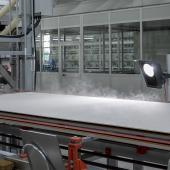Ceramic machinery slowdown eases
The first signs of a recovery are emerging in 2021. Causes of concern include rising prices of raw materials, components and maritime freight transport.
The Italian ceramic machinery and equipment manufacturers are seeing a slightly improvement in their performance.
While the preliminary 2020 full-year results reveal a sharp decline compared to 2019 (total revenues down 18% as the combined result of a 36.6% slump in Italian domestic sales and a 13% contraction in exports), the MECS-Acimac research centre reveals that the companies in the monitored sample are gradually regaining ground.
The fall had also slowed in Q4 of last year, while remaining in negative territory (-10.6% on Q4 2019, but an improvement on the -11.3% of Q3). This was due to the recovery in exports, which returned to -3.4% compared to Q4 of the previous year.
But it is the forecasts for the first quarter of 2021 that are causing the greatest optimism, particularly given that the global ceramic industry is showing clear signs of recovery, with production returning to full capacity in many countries, including Italy, Brazil, India, Spain and Turkey.
In this scenario, it is hardly a surprise that 90% of the companies polled by MECS-Acimac expect to see a stable trend or an increase in sales in the domestic market. They express greater caution with regard to exports, with only one company in ten expecting to see growth and 40% believing that the situation will remain stable.
“From the preliminary full-year figures for 2020 it was already clear that the end of the Covid emergency could coincide with a physiological recovery in the ceramic machinery sector after two years of modest investments on the part of customers,” confirms Acimac’s chairman Paolo Mongardi. “Although we need to be cautious, we are seeing the first signs of the hoped-for recovery in this first quarter of 2021.”
However, there are other factors that are causing concern to business leaders in the ceramic machinery sector in these first few months of the year. These include the significant increases in prices of components and raw materials, particularly cobalt, as well as delays in supplies. Maritime freight rates for container transport between Asia and Europe are also increasing significantly due to the limited availability of containers and above all the insufficient hold capacity available to shipping companies, as well as the skewed supply-demand dynamics caused by the pandemic.
Did you find this article useful?
Join the CWW community to receive the most important news from the global ceramic industry every two weeks























